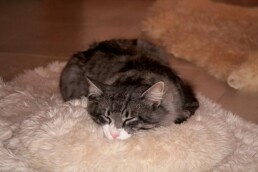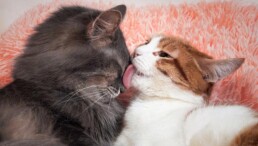Viral rhinotracheitis in cats

In which period is it most at risk?
Autumn is characterized by windy and cold days and it may happen that our reduced immune defenses expose us to the classic seasonal ailments such as cold, fever or sore throat. Likewise our feline friends can suffer from conditioned diseases. One of the most frequent diseases affecting outdoor cats is the viral rhinotracheitis, supported by herpesvirus.
What are the symptoms?
Rhinotracheitisaffects every year a large number of adult cats and kittens. The natural transmission of this disease occurs by direct contact with saliva aerosols, nasal, ocular or fecal secretions from an infected subject, but it is possible that receptive subjects may be indirectly contaminated by people who take care of them. The disease is not contagious for humans being host-specific in cats.
Convalescent cats may host the virus for many months. The incubation period is from 2 to 6 days and the insurgence is characterized by fever, frequent sneezing, conjunctivitis, rhinitis and often salivation. In this case, you should bring your cat immediately to your trusted veterinarian for a consultation. Fever can reach 40.5 ° C and at this stage the depression of the sensorium and anorexia are particularly evident. If the situation is not kept in the due consideration, ocular and nasal discharge may worsen and become more abundant, developing ulcerations in the mouth and in the conjunctiva of the eye. Normally, the risk of death is low and the outcome is favorable, except in young or elderly subjects. The duration of symptoms is 5-10 days in the milder cases and up to 6 weeks in the serious ones. In case of long course of the disease there could be a marked weight loss or secondary bacterial infections.
Young cats and kittens are the subjects most at risk to get the disease from their mother who carries the infectious agent. This scenario is especially common in colonies, where there is no separation between the ill and the healthy subjects and they can enter easily into contact with each other.
The treatment of the disease is mainly supportive and linked to the reduction of the symptoms, but also antibiotics may be useful in case of secondary bacterial infections. You can use nasal decongestants and antihistamines, although their prolonged use can worsen the cat’s symptoms. Therefore it is better to use in association nasal drops or sprays to remove tougher exudates.
At any rate a vaccine is available which should be given at intervals of 3-4 weeks until the age of 12 weeks and after this period the annual revaccination is recommended.
Share
Related posts
The ultimate frontier of cat allergy
There are many people who suffer from allergies caused by the…
Cats and hairball: there is never one without the other
Cause You can get hypnotized by the almost maniac self-care of…

